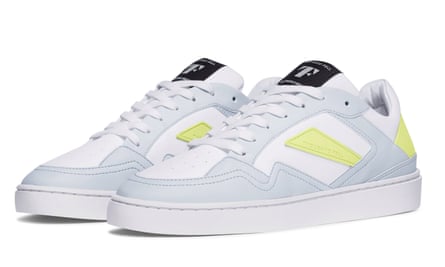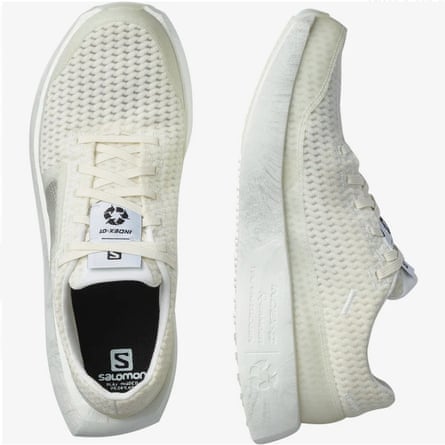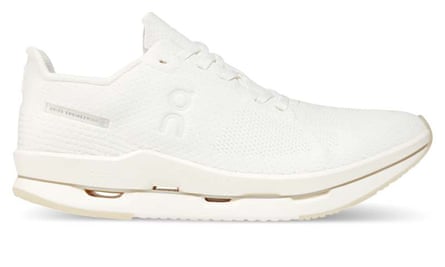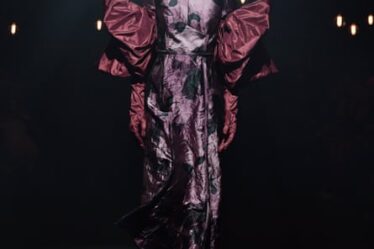
Sneaker sales have long been driven by an intense hype machine. Secret limited-edition drops, queues that wrap around street corners and an endless stream of collaborations have created an industry that was worth a staggering US$70bn (A$103.5bn) in 2020. Which, in sneaker terms, amounts to billions of shoes.
Along with the rest of the fashion industry, the sneaker-hype machine has turned its focus to sustainability. Brands from Louis Vuitton to Adidas have released more “sustainable” sneakers, mostly by incorporating recycled materials. But using waste to make shoes doesn’t address the worst way sneakers plague the environment: the mountains of old shoes sitting in landfill. Now, however, some brands are trying to address that precise problem.
It is estimated that of the 25m pairs of trainers imported to Australia every year, 90% are not recycled. That’s because recycling is not even a possibility, says Tansy Hoskins, the author of Foot Work: What Your Shoes are Doing to the World. “The way brands make shoes means they are very hard to recycle – often dozens of types of materials are glued or bonded together, and metal is used which makes shredding very difficult.”
That dizzying combination of plastic, leather, rubber, foam, metal and adhesives means sneakers could also take up to 1,000 years to biodegrade, making it highly likely almost every trainer you’ve ever owned is still kicking around somewhere.
While some groups, including the Australian Sporting Goods Association, have begun collecting old sneakers, shredding them and turning them into basketball courts, children’s play mats and other types of flooring, the holy grail of circularity is keeping materials at their highest value. In other words, designing sneakers that can be recycled back into sneakers.
International brands, from Nike to Salomon, are on board with the idea of circular sneakers, albeit with varying degrees of success. Designing a shoe that can be recycled is only the first step. From there they have to contend with retrieving the shoes once the wearer is done using them, a process that differs country to country.
Stuart Ahlum, the co-founder of US-based sneaker brand Thousand Fell, started investigating recyclable sneakers in 2018 and launched to the US and Canadian markets one year later. He says the first thing they had to figure out was how to make a sneaker that could be taken apart without contaminating adhesives so that each material could be processed correctly.
Step two was to ensure every component could be separately recycled. They settled on a shoe made from rubber, bioplastics derived from coconut husks and sugar cane, polyester and other plastics including ether foam. The polyester and rubber components are recycled back into materials that can be used again in shoes; the ether foams are open-loop recycled, meaning they can be used in other products. Finally, the bioplastics are sent to an industrial compost.
French outdoor-wear brand Salomon approached the puzzle slightly differently by simplifying the number of materials in their recyclable shoes. In May 2021, they released a sneaker called the Index.01 made of two main materials, a polyester upper and a thermoplastic polyurethane (TPU) sole. When the shoes are returned to Salomon, they are split using scissors.
While the TPU sole can be recycled into a ski boot component, Olivier Mouzin, head of Salomon’s footwear sustainability program, says they have not found a solution for the polyester upper. For now it is being stored in their warehouse. The shoe also has a third material that lines the inside, which is recycled into floor mats.

Mouzin says it’s a priority to localise the recycling processes in each region where the shoes are sold. But recycling infrastructure and regulations differ from country to country. “Things are not moving at the same speed,” Mouzin says. The European Union has passed legislation to ensure companies are responsible for collecting, sorting and recycling their own products at the end of their life, but this is not the case in other markets. In Australia, customers fill out a form in order to return their spent sneakers, which are shipped to a local partner facility for processing.
Swiss running brand On decided to eliminate the need for separation by making shoes out of a single material. The result is the Cloudneo, a bright, white runner made entirely from bio-based castor-bean plastic.
“There are so many pieces we had to look at,” says Ilmarin Heitz, the company’s head of innovation. “The Cloudneo is the first product where we do this successfully.”
According to Heitz, the beauty of the material is that it is thermoplastic, which means it can be recycled over and over again. The plastic is versatile enough to be turned into most of the shoe’s components, from laces to soles. It has only been on the market since June 2022, so there aren’t enough old shoes available to replace virgin inputs, but Heitz is confident this will change over time.
The final piece of the puzzle – and one of the most challenging – is collection.

Thousand Fell and Salomon rely on customers taking the initiative and sending shoes back to them (Thousand Fell offers a $20 credit for every old pair returned). But On have built return into their business model by only offering the Cloudneo shoe on a subscription basis. For US$29.99 or £25 a month, subscribers are sent as many shoes as they wear out, so long as every old pair is posted back to On. At the moment, subscriptions are available in the US, UK, Japan and many European countries, but not Australia.
Heitz believes this model is key to keeping the sneakers in circulation – if you have to send shoes back in order to get a fresh pair, there is less risk they will be thrown in the bin or end up at a facility not equipped to process them.
Salomon decided not to incentivise their customers to return their shoes, believing this would undermine the purity of their intention. “It needs to be a classical behaviour of the consumer,” Mouzin says. “So, we just ask them to send it back.”
While recyclability may be a rising trend, Mouzin says sustainability demands more than this. A truly sustainable sneaker is one that lasts and lasts, even in the face of the endless sneaker-hype-machine and a cultural obsession with fresh white trainers.
Manufacturers need to focus on durability and consumers need to learn “not to switch all the time”, he says. “My dream would’ve been to double the lifespan of this shoe.”



